-
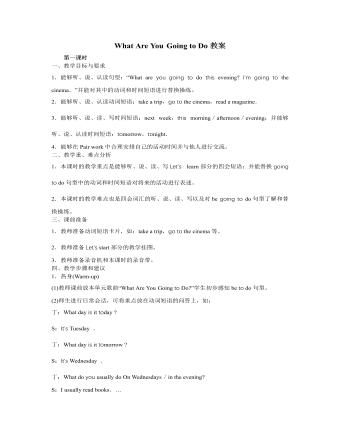
人教版新课标PEP小学英语六年级上册What Are You Going to Do教案
1.热身(Warm-up) (1)全班一起吟唱Let’s chant的歌谣。 (2)单词拼写竞赛 要拼写的单词包括:this morning/afternoon/evening,next week,newspaper, postcard等。可采取小组合作的“接龙式”拼写形式;也可以选取组内一名学生拼写全部单词。拼出单词最快最多的组获胜。 (3)教师出示简明地图,师生问答如下: r:What shop is it? s:It’s a bookstore. r:What can you buy in the bookstore? s:… 在学生回答各商店所出售的物品时,教师根据其回答贴出物品的小卡片,如: Fruit stand:orange,apple,pear,banana….Shoe store:sneakers,sandals,boots….(此时可引导学生说“a pair of sneakers/boots’’等) 2.预习(Preview) Let’s try 教师指着地图中的商店及各商店所出售的物品说:Look!There are so many stores and so many goods.Let’s listen to the tape and find out:①Where is Sarah going? ②What is she going to buy? ③Who is she going with? 教师放三遍Let’s try部分的录音,以上问题可根据学生的实际情况分三次提出,直到多数学生能回答并能将前两项答案填人教师课前画出的表格中。在填表过程中,教师请学生一起拼写其中的四会单词,如:bookstore,comic book。
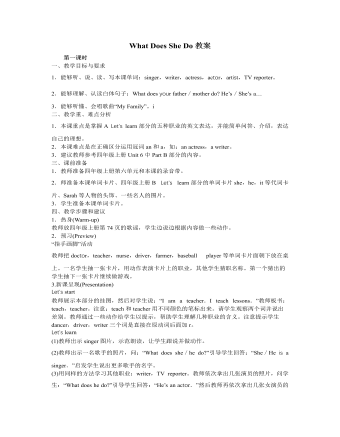
人教版新课标PEP小学英语六年级上册What Does She Do教案
(3)教师就黑板上的内容和学生做对话练习,如:What does your mother do?Where does she work?How does she go to work?教师板书“Where does she work?”和“How does she go to work?”,示范朗读,学生跟说。学生两人一组根据黑板上的语言提示做对话练习。 (4)“看卡片,说句子”活动 教师面前放一摞单词卡片,依次为:职业名称卡片,工作地点卡片和交通方式卡片。活动开始,教师随意从第一摞卡片中抽取一张职业卡片,如:engineer,举起来问:“What does your father do?”学生回答“He’s an engineer.”教师继续抽取一张工作地点卡片,举起来,如:Car company,问:“Where does he work?”学生说:“He works in a Car company.”教师再抽取一张交通方式卡片,如:bus,问:“How does he go to work?学生回答:“He go es to work by bus.”游戏进行几轮后,可以请几名学生轮流代替教师抽卡片,提问题。 (5)教师放本部分的录音,学生跟读。学生两人一组读课文对话。 (6)学生两人一组做对话替换练习。 (7)教师指导学生书写四会句子。 4.巩固和延伸(Consolidation and ex tension) Group work

人教版新目标初中英语九年级上册Teenagers should be allowed to choose their own clothes教案2篇
Step 1 Greeting Greet the class and check the homeworkStep 2 A duty report The S on duty gives a report on the rules in his home and lead in 3a “Sun Fei’s and Wu Yu’s rules” Step 3 ReadingSs read the conversation and write the two girls’ rules in the chart. Check the answers.Get Ss to read after the tape and then read aloud by themselves. Then, T explains the language points.Step 4 Pairwork 3bRole play. Use the information in chart to practice with the conversation in 3a covered. They can look at the sample conversation in the right box.Step 5 Task 2 “Who’s the best reporter?”Make a survey by asking any 5 students the questions in the chart in activity 4. Then give out a report about it. See who is the best reporter? And the best reporter will get a nice ball-pen.Step 6 Summary and homework:Write out the report in your exercise-books.Period ThreeStep 1 Greeting and a duty reportThe S gives a duty report talking about his experience of being late for school. Lead in the question “Do you ever get to school late? How often do you get to school late? Always, usually, sometimes, or never?Step 2 1a Get Ss to finish writing.Step 3 Pairwork 1b Get Ss to talk about their answers with their partners using the sample conversation in the box on the right.Step 4 Listening practice2a Lead-in: What will happen if you get to school late? What about Peter? Let’s listen to a conversation between Peter and his father. Get Ss to finish 2a (As usual, for the first time, Ss only listen.) Check the answers.

人教版新目标初中英语九年级上册I like music that I can dance to教案
教学目标: 1. Express preferences2. Talk about one’s likes and dislikes and the reasons3. Learn to express one’s opinions 4. Learn to write a reply 语言功能: 1) Talk about one’s preferences, using t he relative clause2) Talk about people’s likes and dislikes and the reasons3) Talk about opinions语言结构: Relative clauses with that and who语言目标:What kind of music do you like?I like music that I can sing along with.I love singers who write their own music.We prefer music that has great lyric.重点词汇及短语:heart, photography, interest, class, whatever, miss, okay, expect, sweet, taste, itself, laboratory, cancer, increase, biscuit, main, care, prefer… to…, remind somebody of …, dance to, sing along with, be sure to, interest somebody, make somebody adj., to be honest, suit somebody, on display, catch up教学重难点:What do other people think of the different kinds of things? How to express one’s opinions? 学习方式:讨论,合作学习情感目标:通过本单元的学习,能提高学生的艺术鉴赏能力和审美情趣,并引导学生养成健康的饮食习惯。课时安排5课时第一课时:Section A: 1a-2c第二课时:Section A : 3a-4第三课时:Section B:1-2c, Self check2第四课时:Section B: 3a-4, Self check1第五课时:Self check ReadingI like music that I can dance to.

人教版新目标初中英语九年级上册I used to be afraid of the dark教案
内容提示1.本单元主要内容是学会used to结构。Used to +动词原形表示过去经常、以前常常,只用于过去式中,用来表示现在已不存在的习惯或状态。例如:They used to play football together.他们过去常在一起蹋足球。(现在不在一起踢了)2.used to的疑问形式和否定形式为Did you use to…?和I didn’t use to… 也可以用Used you to…?和I used not to…但现在多使用前者。例如:Did you used to swim in the river? 你过去常在河里游泳吗?I didn’t use to play the piano. 我以前并不经常弹钢琴。教学目标一、学习目标(Language Goal) 1.学会陈述自己过去常做的事情。2.学会陈述自己过去的爱好等。3.能够表达自己现在和过去在外表、性格、娱乐等方面的变化。4.能够表达朋友、家人等现在和过去的变化。二、语言结构(Language Structures) 1.I used to be short when I was young. 我年轻时个子很矮。 2. —Did you use to have straight hair? 你过去是直发吗?—Yes, I did. 是的。 3. —Did you use to play the piano? 你过去弹钢琴吗?—No, I didn’t. 不,我不弹。 4.I used to be afraid of dark. 我过去害怕黑暗。 5.I’m terrified of the snakes. 我害怕蛇。

人教版新目标初中英语九年级上册How do you study for a test教案2篇
内容提示本单元主要内容是学会利用verb十by/with gerund表示方式方法来讨论学习英语的策略,认识自己在学习方面的长处和不足。初步了解现在完成时的结构和用法。现在完成时由助动词have/has+动词的过去分词构成,主要表示过去发生的某一动作对现在仍有影响或造成的后果,常与already,yet,just,ever,never等副词连用。教学目标一、学习目标(Language Goal) 1. Talk about how to study . 学会讨论各种学习方法和策略。2. Find out your suitable learning methods. 找出适合自己的学习方法。 二、语言结构(Language Structures) 1. Verb + by with gerund by+动名词短语 表示“通过…途径,方法” 2. How questions have引导的特殊疑问句 三、目标语言(Target Language) 1. How do you study for tests ? 你是怎样准备考试的?Well , I study by working with my classmates. 哦,我和同学们一起学习。2. Have you ever studied with a group ? 你曾经参加过学习小组吗?Yes , I have . I’ve learned a lot that way . 是的,参加过。通过这种方式我学了许多。

人教版新目标初中英语九年级上册It must belong to Carla教案
一、Section A该部分有4个模块。第一模块围绕Whose volleyball is this? 这一话题展开思维( 1a)、听力(1b)、口语( 1c)训练;第二模块围绕上一模块中的话题进行听力( 2a-2b)、口语训练( 2c);第三模块继续围绕前两个模块中的“making inferences”展开训练。训练形式为阅读排序( 3a)和两人问答(3b);第四模块仍就上一话题展开讨论。二、Section B该部分有4个模块。第一模块要求根据图画和所提供的单词写出合理的句子;第二模块在听力( 2a-2b)和分角色口语训练( 2c)的基础上,继续进行“推测”训练; 第三模块围绕“Strange events in Bell Tower neighborhood”这一话题展开阅读( 3a)和写作(3b -3c)训练;第四模块以dream为话题展开小组活动。三、Self Check该部分有3个模块。第一模块以填空形式对所学词汇进行训练;第二模块就8个谚语展开阅读和讨论。

人教版新目标初中英语九年级上册Where would you like to visit教案2篇
The First PeriodⅠ.Teaching Aims and DemandsKnowledge Objects(1) Key Vocabularytiring, educational, fascinating, thrilling, peaceful, exotic, trek, jungle, take it easy, explore, historic, site(2) Target LanguageWhere would you like to go on vacation?I’d like to trek through the jungle, because I like exciting vacations.2. Ability Objects(1)Train students to talk about places they would like to visit with the target language.(2)Train students to describe vacations with different adjectives.(3)Train students' listening skill.3. Moral Object,It′s more interesting to go on vacating somewhere instead of staying at home.Ⅱ. Teaching Key Points1. Key Vocabularytiring, educational, fascinating, thrilling, peaceful, exotic, trek, jungle, take it easy, explore, historic, site2. Target LanguageTalk about different places with the target language.Ⅲ. Teaching Difficult Points1. Describe vacations with different adjectives.2. Talk about different places with the target language.Ⅳ. Teaching Methods1. Teaching by illumination2. Teaching by doing chain drills3. Teaching by pairworkⅤ. Teaching Aids1. A tape recorder2. Some pictures of different places with famous views
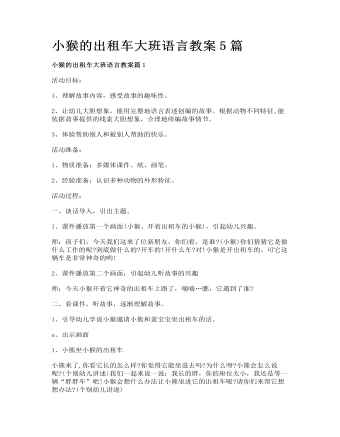
小猴的出租车大班语言教案5篇
1、讲述故事,加深理解。教师操作教具,讲述故事,穿插提问:a小猴发现蛋宝宝和小熊遇到什么困难?如果你是小猴你会怎样解决这个问题?请小朋友积极想办法。b小朋友听故事里的小猴是怎样做的。乘客对小猴设计的出租车是否“满意”(出示字卡满意),为什么?你们喜欢小猴和它的出租车吗?是否也“满意”?2、大胆想象仿编故事。引发仿编兴趣:小猴的名气越来越大了,森林里的小动物都来坐它的出租车。提问:长颈鹿和小刺猬遇到了什么困难?小猴是怎样解决的?森林里还有谁也乘坐小猴的出租车?他们可能遇到什么困难?小猴能解决吗?我们也帮小猴想想让所有的小动物都能顺利的乘坐出租车。(幼儿分组讨论,仿编故事,鼓励幼儿把故事讲给大家听。)
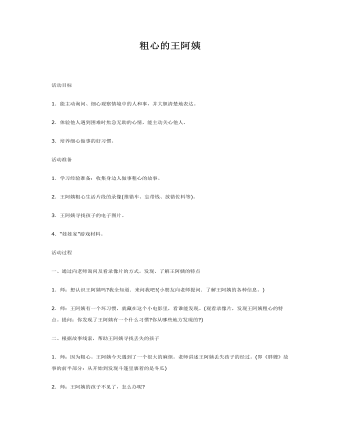
大班语言教案:粗心的王阿姨
2.体验他人遇到困难时焦急无助的心情,能主动关心他人。3.培养细心做事的好习惯。活动准备1.学习经验准备:收集身边人做事粗心的故事。2.王阿姨粗心生活片段的录像(推错车、忘带钱、放错佐料等)。3.王阿姨寻找孩子的电子图片。4.“娃娃家”游戏材料。活动过程一、通过向老师询问及看录像片的方式。发现、了解王阿姨的特点1.师:想认识王阿姨吗?我全知道.来问我吧!(小朋友向老师提问.了解王阿姨的各种信息。)2.师:王阿姨有一个坏习惯,就藏在这个小电影里,看谁能发现。(观看录像片,发现王阿姨粗心的特点。提问:你发现了王阿姨有一个什么习惯?你从哪些地方发现的?)
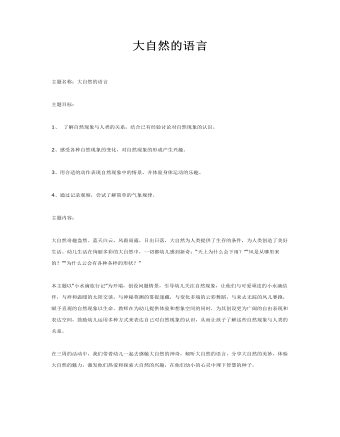
大班美术教案:大自然的语言
主题目标:1、 了解自然现象与人类的关系,结合已有经验讨论对自然现象的认识。2、感受各种自然现象的变化,对自然现象的形成产生兴趣。3、用合适的动作表现自然现象中的情景,并体验身体运动的乐趣。4、通过记录观察,尝试了解简单的气象规律。主题内容:大自然奇趣盎然。蓝天白云,风霜雨露,日出日落,大自然为人类提供了生存的条件,为人类创造了美好生活。幼儿生活在绚丽多彩的大自然中,一切都幼儿感到新奇:“天上为什么会下雨?”“风是从哪里来的?”“为什么云会有各种各样的形状?”
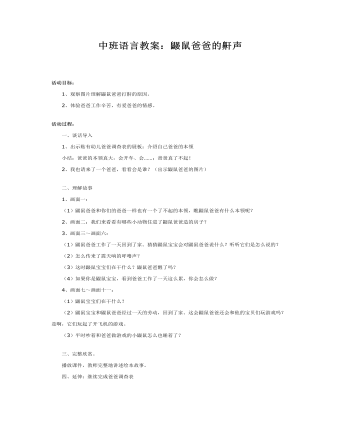
中班语言教案:鼹鼠爸爸的鼾声
活动过程: 一、谈话导入1、出示贴有幼儿爸爸调查表的展板:介绍自己爸爸的本领 小结:爸爸的本领真大,会开车、会……;爸爸真了不起!2、我也请来了一个爸爸,看看会是谁?(出示鼹鼠爸爸的图片) 二、理解故事1、画面一: (1)鼹鼠爸爸和你们的爸爸一样也有一个了不起的本领,瞧鼹鼠爸爸有什么本领呢?2、画面二:我们来看看有哪些小动物住进了鼹鼠爸爸造的房子?3、画面三~画面六: (1)鼹鼠爸爸工作了一天回到了家。猜猜鼹鼠宝宝会对鼹鼠爸爸说什么?听听它们是怎么说的? (2)怎么传来了震天响的呼噜声?
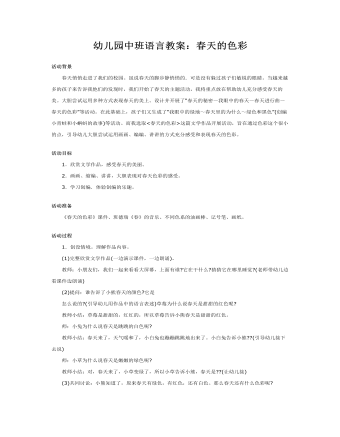
幼儿园中班语言教案:春天的色彩
活动目标1.欣赏文学作品,感受春天的美丽。2.画画、缩编、讲讲,大胆表现对春天色彩的感受。3.学习创编.体验创编的乐趣。活动准备 《春天的色彩》课件、班德瑞《春》的音乐、不同色系的油画棒、记号笔、画纸。活动过程1.创设情境。理解作品内容。(1)完整欣赏文学作品(一边演示课件,一边朗诵)。 教师:小朋友们,我们一起来看看大屏幕,上面有谁?它在干什么?猜猜它在哪里睡觉?(老师带幼儿边看课件边朗诵)
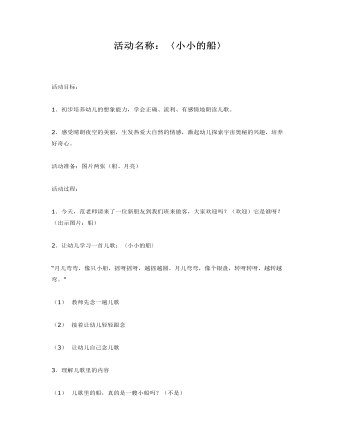
幼儿园中班语言教案:小小的船
2.感受晴朗夜空的美丽,生发热爱大自然的情感,激起幼儿探索宇宙奥秘的兴趣,培养好奇心。活动准备:图片两张(船、月亮)活动过程:1.今天,范老师请来了一位新朋友到我们班来做客,大家欢迎吗?(欢迎)它是谁呀?(出示图片:船)2.让幼儿学习一首儿歌:〈小小的船〉“月儿弯弯,像只小船,摇呀摇呀,越摇越圆。月儿弯弯,像个银盘,转呀转呀,越转越弯。”(1) 教师先念一遍儿歌(2) 接着让幼儿轻轻跟念(3) 让幼儿自己念儿歌
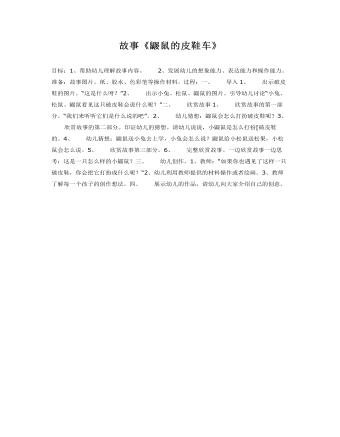
中班语言教案 鼹鼠的皮鞋车
2、发展幼儿的想象能力、表达能力和操作能力。准备:故事图片。纸、胶水、色彩笔等操作材料。过程:一、 导入1、 出示破皮鞋的图片。“这是什么呀?”2、 出示小兔、松鼠、鼹鼠的图片。引导幼儿讨论“小兔、松鼠、鼹鼠看见这只破皮鞋会说什么呢?”二、 欣赏故事1、 欣赏故事的第一部分。“我们来听听它们是什么说的吧”。2、 幼儿猜想:鼹鼠会怎么打扮破皮鞋呢?3、 欣赏故事的第二部分。印证幼儿的猜想。请幼儿说说,小鼹鼠是怎么打扮[破皮鞋的。
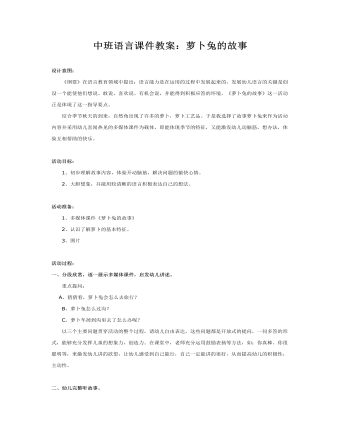
中班语言课件教案:萝卜兔的故事
活动目标:1、初步理解故事内容,体验开动脑筋,解决问题的愉快心情。2、大胆想象,并能用较清晰的语言积极表达自己的想法。 活动准备:1、多媒体课件《萝卜兔的故事》2、认识了解萝卜的基本特征。3、图片
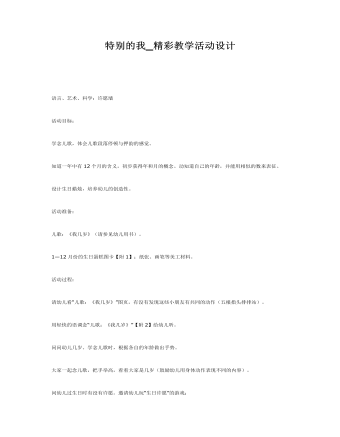
中班语言课件教案:特别的我
活动目标:学念儿歌,体会儿歌段落停顿与押韵的感觉。知道一年中有12个月的含义,初步获得年和月的概念。动知道自己的年龄,并能用相似的数来表征。设计生日蜡烛,培养幼儿的创造性。活动准备:儿歌:《我几岁》(请参见幼儿用书)。1—12月份的生日蛋糕图卡【附1】;纸张、画笔等美工材料。
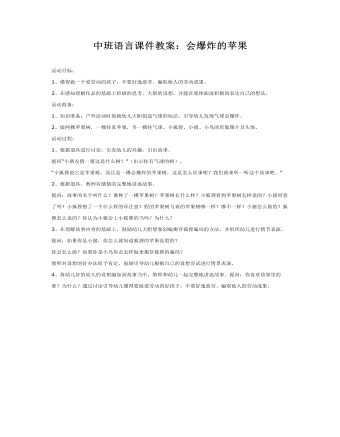
中班语言课件教案:会爆炸的苹果
2、在感知理解作品的基础上积极的思考,大胆的设想,并能在集体面前积极的表达自己的想法。 活动准备: 1、知识准备:户外活动时鼓励幼儿大胆创造气球的玩法,引导幼儿发现气球会爆炸。 2、做两棵苹果树,一棵挂真苹果,另一棵挂气球。小狐狸、小猪、小鸟的形象图片及头饰。 活动过程: 1、根据道具进行讨论,引发幼儿的兴趣,引出故事。 提问“小朋友猜一猜这是什么树?”(出示挂有气球的树)。 “小狐狸说它是苹果树,而且是一棵会爆炸的苹果树,这是怎么回事呢?我们就来听一听这个故事吧。”

中班语言课件教案:戴眼睛的小猫
1、讲述故事《戴眼镜的小猫》(投影幼儿用书)故事内容:在一座红房子里,住着一位老奶奶和一只小猫。老奶奶年纪大了,每次看报纸时都要戴一副紫色的眼镜,小猫看了很羡慕。(做戴眼镜看报纸状)有一天,老奶奶看完报纸,没来得及把眼镜放好,就被另一位老奶奶叫走了。小猫终于有机会了,它戴着老奶奶的眼镜,高兴地往门口跑,走到大门口,一看,哎呀,门槛怎么变高啦!它用足力气使劲往上跳。只听“咚”的一声,小猫重重地被摔倒在地上。小猫又觉得肚子饿了,想找点东西吃。它刚走到老鼠洞口,就看见对面走来一只很大很大的老鼠。(做肚饿状、大老鼠状)小猫吓得掉头就跑。它边跑边想:这准是一副魔镜,我还是把它给老奶奶放回去吧!小猫悄悄的把眼镜放到了老奶奶的桌上。故事讲完了,好听吗?(好听)我们现在来回忆一下故事讲了什么。(根据幼儿用书上的图画,提问题)——在一座房子里住着谁?(老奶奶和一只小猫)——老奶奶每次看报纸都要戴什么?为什么?(眼镜因为老奶奶年纪大了,眼睛不好)——小猫看见老奶奶戴眼镜很羡慕,有一天它戴上眼镜高兴地跑到大门边,发生了什么?(门槛变高,被重重地摔倒在地上)——小猫肚子饿了,它跑到老鼠洞口又发生了什么?(看见一只很大很大的老鼠,吓得掉头就跑)
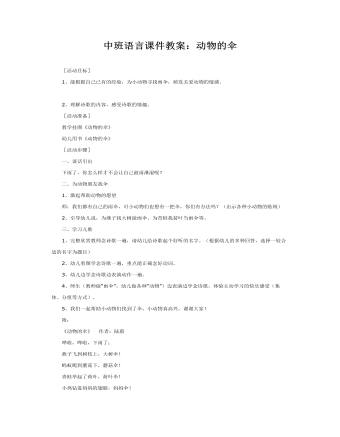
中班语言课件教案:动物的伞
2、理解诗歌的内容,感受诗歌的情趣。 [活动准备] 教学挂图《动物的伞》 幼儿用书《动物的伞》 [活动步骤] 一、谈话引出 下雨了,你怎么样才不会让自己被雨淋湿呢?

